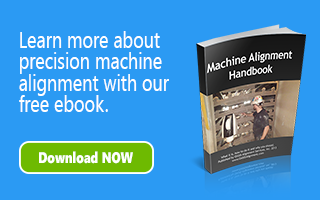As with most large pieces of production equipment, precision is key for optimal operating efficiency of hydroelectric power generating units. Unfortunately, there are many factors that can effect operations and cause component damage, leading to unplanned shutdowns. Often during these shutdowns, damaged components must be disassembled, rebuilt or refurbished to OEM specifications, and then precisely reassembled prior to start up. For many years, in order to align the components within a hydro power unit, engineers have used precision levels, tight wires and plumb bobs. This method, though at times effective, can be extremely time consuming and prone to human error, especially during a component rebuild and reassembly project.

Leica AT960 Laser Tracker is used to take measurements on the downstream embedded ring and turbine casing.
With the use of newer, innovative 3D metrology tools such as the Leica AT960 Laser Tracker, the inspection and alignment of turbines, shafts, bearings, and other components within power generating units, can now be done much faster and with a higher degree of accuracy than traditional methods. In this post, we provide an overview of a recent OASIS project where the use of a laser tracker excelled during Phase I of a hydro power component rebuild and reassembly project.
The Challenge
A hydro power generating plant began having operational issues when the wicket gates of one of their units became impinged. Plant owners suspected the problem was the result of alkali-aggregate reaction (AAR) in the concrete where the embedded distributor ring is located. AAR is a chemical reaction between the alkali in cement and the reactive minerals in aggregate and additives that takes place when moisture is present. The reaction can cause significant expansion and cracking of concrete. In order for the gates to again function properly, the plant elected to grind the gate edges in order for them to open and close freely. Though this solved the problem with water flow initially, it caused additional issues within the unit, including the subsequent movement of the inner barrel, shaft and runner blades. Enerserv Corporation, an engineering consulting firm that provides inspection, maintenance, installation and repair of hydroelectric and thermal energy generating equipment, was called in to diagnose the problem and perform repairs. When the team from Enerserv removed the bolts that secure the runner casing to the embedded ring, they were surprised to see the casing actually “spring” back into its specification shape. This led them to suspect that the distributor ring was out of concentricity due to the AAR. For additional inspection support, the plant chose to bring in OASIS Alignment Services to assist Enerserv with the precision inspection of the entire unit during the shutdown and disassembly of the components.

Red dots represent where permanent reference monuments were strategically placed for use during this project and for measurements needed on either unit in the future.
Bruce Littlefield, OASIS Senior Project Manager, met with Enerserv Owner and Senior Project Manager, Davie Lausier and plant representatives to create a plan for Phase I of the hydro power unit rebuild project. The OASIS portion of Phase I involved an OASIS metrology engineer using a Leica Laser Tracker to:
- Measure concentricity of the embedded ring and throat ring
- Inspect and measure runner blades and clearances
- Inspect and measure shaft centerlines
- Compare component centerlines
- Establish permanent reference monuments
- Permanent reference monuments will be used during the disassembly of all components (Phase II) and the reassembly and alignment of the rebuilt components (Phase III)
- Additionally, permanent reference monuments can be used for any future alignment or precision measurement projects needed on this unit or the adjacent unit and to measure suspected building movement or settling
Moving Forward
Phase II of this project will involve the complete disassembly of the unit including the removal of the runner blades, the shaft from the draft tube, and the lower half of the runner case. Once the unit is disassembled, a full set of measurements will be gathered on the embedded components in order to determine the extent of the impingement. Phase III of the project, will include the reassembly of all components and the final alignment. “I was so impressed with the speed at which the OASIS engineer was able to gather the measurement data using the laser tracker,” said Dave Lausier, Owner/Senior Project Manager, Enerserv Corporation. “I am used to the more traditional methods of measurement and admit that I was skeptical, at first. But, now that I have seen the power of this laser tracker with my own eyes, I will be sure to use OASIS on future projects.” Be sure to check back to our Industry Blog for the results from Phases II & III of this hydro turbine project. If you would like to learn how OASIS can assist with your turbine project, please contact us. For more information on the services provided by Enerserv Corporation, please visit www.enerserv.com.

